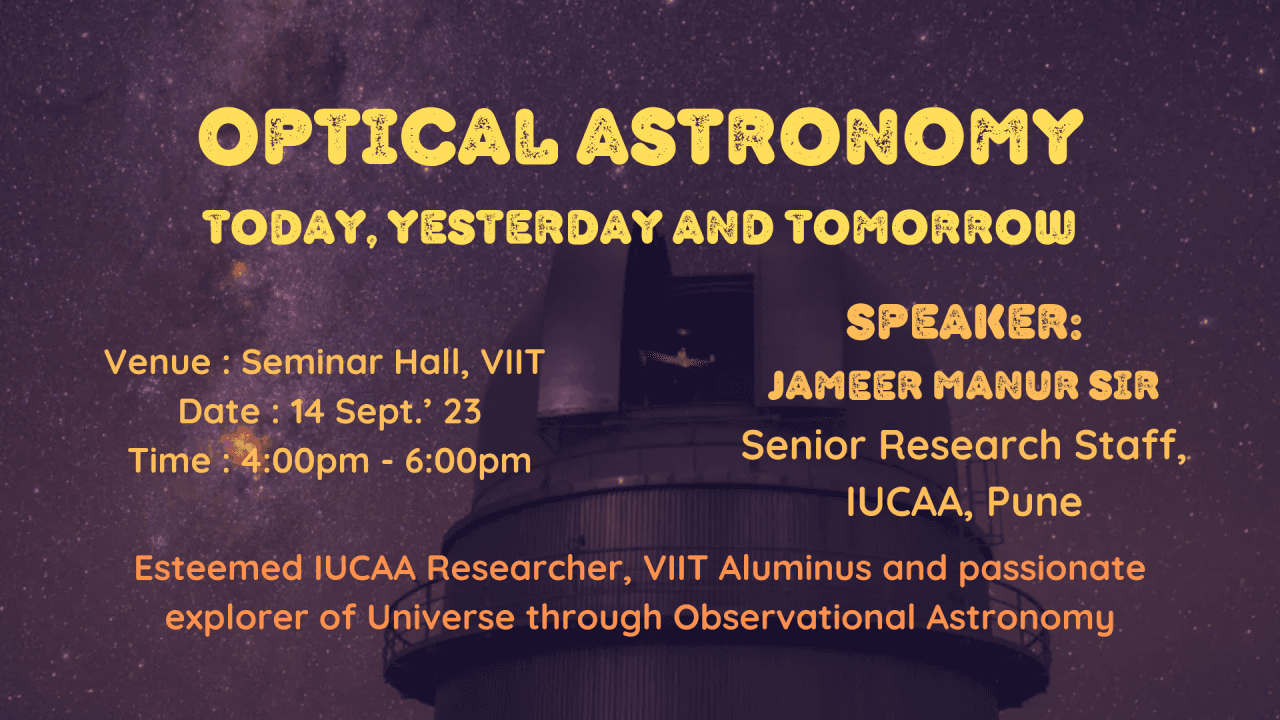Speaker: Gautam Kulkarni
Date: 17 February' 2024
Location: Lecture Hall C103, Electronics and Telecommunication (EnTC) Department, VIIT
Attendees: 22 Students

Introduction
On [insert date], the Antariksh Club organized an enriching internal talk presented by Gautam Kulkarni, aimed at enhancing the knowledge of students regarding radio astronomy. The session brought together 22 students from the Electronics and Telecommunication department in Lecture Hall C103. The talk sought to demystify the field of radio astronomy, which plays a crucial role in our understanding of the universe through the observation of radio waves.
Agenda of the Talk
Gautam Kulkarni’s presentation was structured around several core themes that outlined the fundamentals and advancements in radio astronomy:
1. Historical Background
The talk commenced with an overview of the historical milestones in radio astronomy, highlighting key figures:
- Karl Jansky (1930s): Recognized as the father of radio astronomy, Jansky discovered radio waves emanating from the Milky Way, marking the inception of the field.
- Grote Reber: He constructed the first radio telescope in his backyard in 1937, which allowed for systematic observations of celestial radio sources.
- Jocelyn Bell Burnell (1967): Her discovery of pulsars provided critical evidence for neutron stars and expanded the understanding of stellar evolution.
This historical context helped students appreciate the evolution of radio astronomy from its inception to its current state.
2. Understanding the Radio Sky
Kulkarni elaborated on the importance of observing the universe at specific wavelengths, particularly focusing on:
- 1.9m Incident Wavelength: This segment of the radio spectrum is significant for observing cosmic phenomena, including the study of hydrogen and other elements in space.
3. Sources of Radiation
The speaker detailed two primary sources of radio radiation:
- 21 cm Hydrogen Line (H1 Line): This line, produced by the hyperfine transition of neutral hydrogen atoms, is vital for mapping the structure of galaxies. Kulkarni explained the physics behind the H1 line, discussing:
- Spin Configuration of Electrons and Protons: The interaction between electron and proton spins results in distinct energy states.
- Energy Difference and Frequency Calculation: The energy difference of 5.87 µeV correlates with a frequency of 1.42 GHz, which is crucial for radio observations.
- Neutron Stars (Pulsars): The discussion on pulsars covered:
- Their characteristics as rapidly rotating neutron stars that emit beams of electromagnetic radiation.
- The mechanisms through which pulsars are detected, emphasizing the interaction of photons and electrons in extreme gravitational fields.
4. Antennas and Receivers
Gautam Kulkarni explained the technological aspects of radio astronomy by introducing the audience to the various types of antennas and receivers:
- Types of Antennas:
- Dipole Antenna:
- Characteristics: Omnidirectional, large signal coverage.
- Applications: Used in many radio astronomy projects for general-purpose observations.
- Horn Antenna:
- Characteristics: High gain and directivity with low sidelobes.
- Applications: Preferred for precise measurements and directing radio signals.
- Parabolic Antenna:
- Characteristics: Extremely high gain, enabling precise long-distance signal transmission.
- Applications: Widely used in large radio telescope arrays for focused observations.
This segment included visual aids demonstrating the designs and applications of these antennas.
5. Collaborative Observations: How Do Telescopes Work Together?
Kulkarni explained the principles of collaborative observations in radio astronomy:
- Same Source, Different Signals: Multiple telescopes can observe the same astronomical source, providing complementary data.
- Interferometry:
- This technique allows astronomers to combine signals from multiple telescopes to enhance resolution and sensitivity.
- Students were introduced to terms such as baseline (the distance between telescopes) and how varying this distance affects the quality of the observations.
- Objective Parameters: The speaker covered key observational parameters that are critical in radio astronomy:
- Intensity: The power received per unit area, crucial for quantifying signals.
- Flux: The total amount of energy received over time, influencing the detection of faint sources.
- Brightness Temperature: This concept relates to the temperature of a black body that would emit the observed intensity of radiation, providing insight into the physical conditions of astronomical sources.
6. Introducing GMRT (Giant Metrewave Radio Telescope)
The talk concluded with an introduction to the GMRT, one of the most significant radio telescopes located in India:
- Overview of GMRT:
- The telescope comprises an array of 30 antennas, enabling a wide range of astronomical observations.
- Discussion of its contributions to various research areas, including cosmology and astrophysics.
- Research and Discoveries: Kulkarni shared notable discoveries made using GMRT, emphasizing its role in advancing our understanding of the universe.
Audience Engagement
The presentation fostered a highly interactive atmosphere, with students actively engaging with the content. Key points of engagement included:
- Q&A Session: Attendees asked questions related to the technical aspects of radio telescopes, the implications of radio wave observations, and future advancements in radio astronomy.
- Discussion on Career Paths: Students expressed interest in pursuing careers in astronomy and astrophysics, with Kulkarni providing guidance on educational pathways and research opportunities.
Conclusion
Gautam Kulkarni’s talk successfully illuminated the fascinating field of radio astronomy, blending historical context, technical knowledge, and current research trends. The insights gained from the presentation not only deepened students' understanding but also inspired further exploration into the cosmos.



